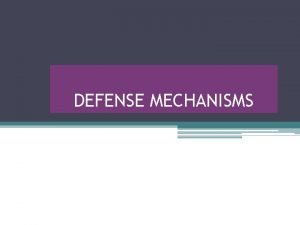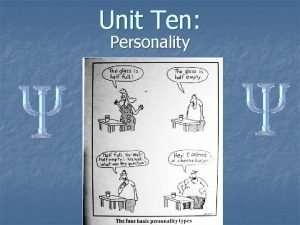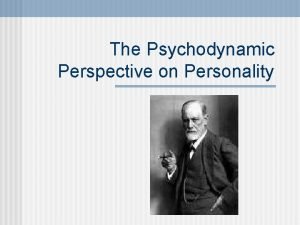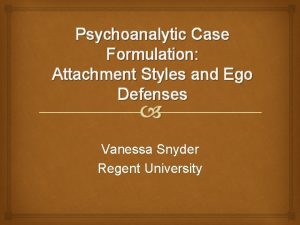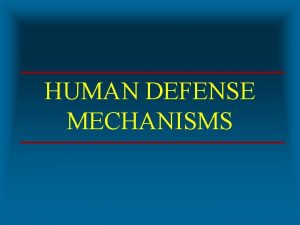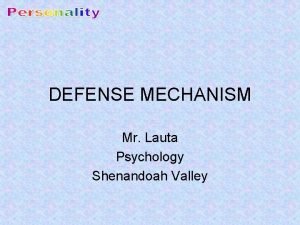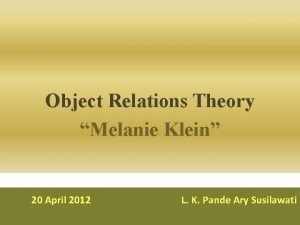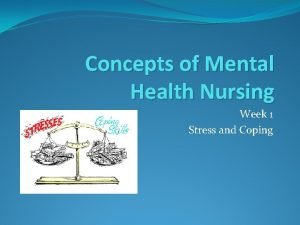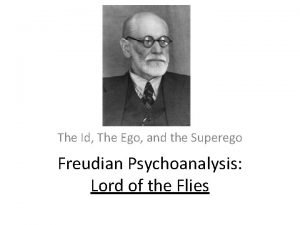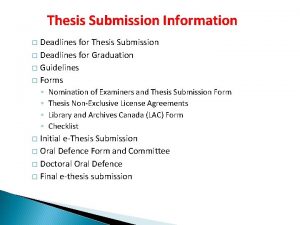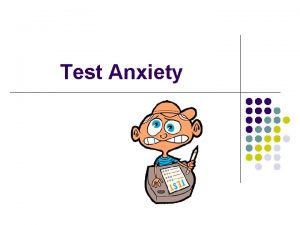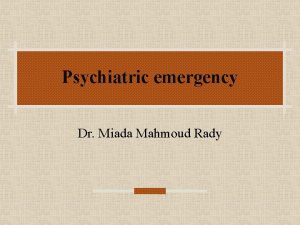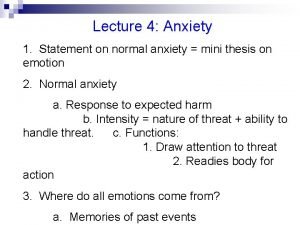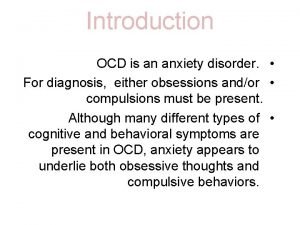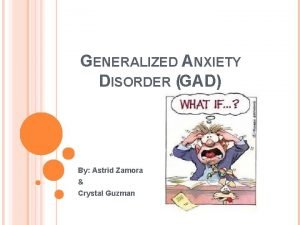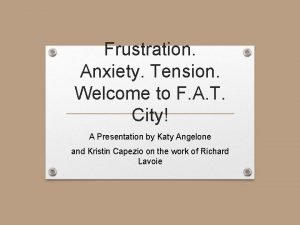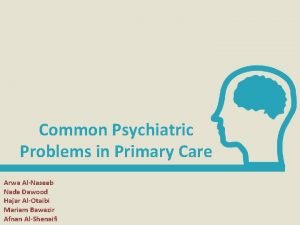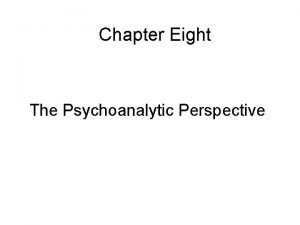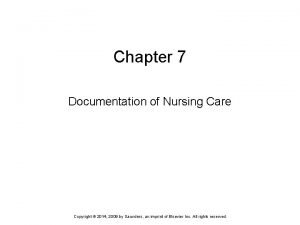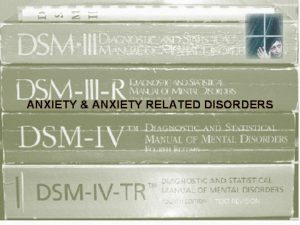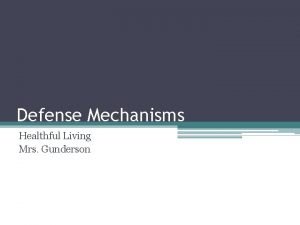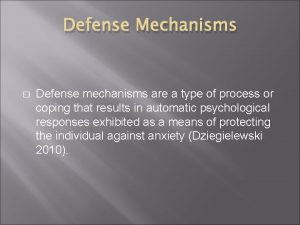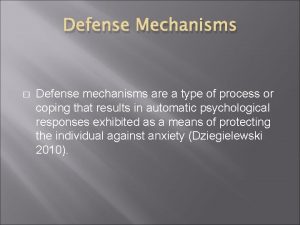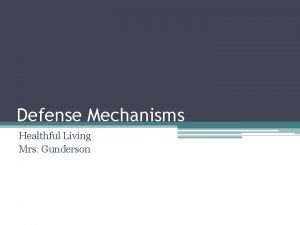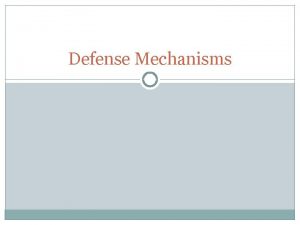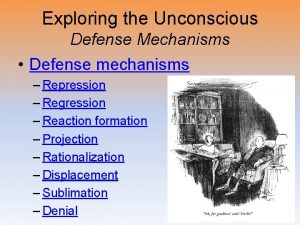DEFENSE MECHANISMS Introduction According to Freud anxiety is















































- Slides: 47

DEFENSE MECHANISMS

Introduction • According to Freud, anxiety is an unpleasant inner state that people seek to avoid. • Anxiety acts as a signal to the ego that things are not going right. • Then the ego react by many defense mechanisms

Contd. . . • Ego-defense mechanisms are learned, usually during early childhood. • Although people may knowingly use these mechanisms, in many cases these defenses occur unconsciously and work to distort reality.


Function of Ego • To satisfy the id's impulses • Not offend the moralistic character of the superego • While still taking into consideration the reality of the situation.

Definition of Ego defense mechanisms • Defense mechanisms are psychological strategies by ego brought into play by individuals, groups to cope with reality and to maintain self-image. • Healthy persons normally use different defenses throughout life.

• Denial: - Refusal to accept external reality because it is too threatening. - Arguing against an anxiety provoking stimuli by stating it doesn't exist.

• Reduce anxiety by refusing to consciously acknowledge the more unpleasant aspects of external reality. • Example: A man who is told he has terminal cancer denies the diagnosis by telling his family he had a little tumor on his lung and his doctor "removed all of it. "

Fantasy • Imagined events or mental images (e. g. , daydreaming) to express unconscious conflicts, gratify unconscious wishes, or prepare for anticipated future events.

Compensation • The act of "making up" for a real or imagined inability or deficiency with a specific behavior to maintain self-respect or self-esteem.

Contd. . • The person overcomes an inability by becoming proficient in another area. • This may occur on a conscious or unconscious level.

• Example: 1) A short girl may become manager of a basketball team because she is not tall enough to qualify for the team. 2) An unattractive man selects expensive, stylish clothes to draw attention to himself.

Conversion • The transferring of a mental conflict into a physical problem. Example: - A woman experiences sudden blindness after witnessing a robbery. - A man develops paralysis of his lower extremities after he learns his wife has terminal cancer.

Displacement • A mechanism that serves to transfer feelings such as frustration, hostility, or anxiety from one idea, person, or object to another. The substitute target is less threatening and allows the person to release emotional reactions.

• Example: • Yelling at one person when you are angry at another. • Parents often displace feelings of anger or frustration towards their children since they are more tolerant recipients of such displacement than other adults.

Dissociation • The act of separating and detaching a strong, emotionally charged conflict from one's consciousness.

Contd. . • This detached information is blocked from conscious awareness, which allows the person to defer or postpone experiencing an emotional impact or painful feelings.

Example: • A woman who raped found walking on streets. When examined, she was found in a state of traumatic amnesia. - She separated and detached her emotional reaction to the rape from her consciousness.

Identification • Also referred to as "the imitator" • Unconsciously, people use it in an attempt to identify with the personality and traits of another. Such behavior preserves one's ego or self, the organized conscious mediator between person and reality.

EXAMPLE: • A young man chooses to become a doctor just like his father. • A man dresses, walks, talks and acts like …. • An adolescent girl dresses, walks, talks and acts like…. .

Reaction Formation: • Converting unconscious wishes or impulses that are perceived to be dangerous into their opposites.

• This defence can work effectively for coping in the short term, but will eventually break down. • Example: A jealousy boy who hates his brother may show him exaggerated respect and affection towards him.

• Example: A man who dislikes his mother-in-law may act very politely and courteously toward her.

Projection • Often termed the "scapegoat" defense mechanism. The person rejects unwanted characteristics of self and assigns them to others. • The person may blame others for faults, feelings, or shortcomings that are unacceptable to self.

• Behaviour that is completely the opposite of what one really wants or feels; taking the opposite belief because the true belief causes anxiety.

Example: • A man who is late for work states, "My wife forgot to set the alarm last night so I overslept.

• After spilling a glass of milk while playing cards with a friend, a 10 -year-old tells his mother, "Johnny made me spill the milk. He told me to hurry up and play. • A common retort is "You made me do it!", or, "See what you made me do!".

Repression • Process of pulling thoughts into the unconscious and preventing painful or dangerous thoughts from entering consciousness. • Memory lapse or lack of awareness of one's own situation and condition.

• The emotion is conscious, but the idea behind it is absent. • Example: 1. Forgetting a loved one’s birthday after a fight. 2. A man has a serious auto accident and is unable to recall the feelings of fear following the accident.

Regression • Retreating or reverting to past levels of behavior that reduce anxiety, allow one to feel more comfortable, and permit dependency. • Example: 1. A 27 -year-old woman acts like a 17 -year-old on her first day with a fellow employee.

2. A 5 -year-old boy who is toilet trained becomes incontinent during his father's hospitalization. 3. Four years old begins to suck his thumb & wet bed shortly after the birth of a sibling

Sublimiation • The re-channeling of consciously intolerable or socially unacceptable impulses or behaviors into activities that are personally or socially acceptable.

Example: • A college student who has hostile feelings re-channels them by joining the debate team. • Aggressiveness might be transformed into competitiveness in business or sports.

Suppression • Willfully or voluntarily putting unacceptable thought for feeling out of one's mind with the ability to recall the thought or feeling at will.

• A deliberate, intentional exclusion from the conscious mind is referred to as voluntary forgetting. • This mechanism is generally used to protect one's self-esteem.

• Example: • "I'd rather not talk about it right now“ • "Let's talk about my accident later, “ • "I'm taking a vacation. My problems will still be here when I get back. "

Substitution • The unconscious act of replacing a goal when it is blocked. Also defined as the replacement of consciously unacceptable emotions, drives, attitudes, or needs by those that are more acceptable.

Contd. . . • This mechanism is used to reduce frustration and promote feelings of satisfaction or success.

Example: • A student nurse in a associate degree program who feels unable to master the clinical competencies elects to become a respiratory technician.

Example: • The individual accepts a modified form of their original goal (i. e. becoming a high school basketball coach rather than a professional athlete. )

Rationalization • The act of justifying ideas, actions, or feelings with good, acceptable reasons or explanation.

Example: • A lady who cannot afford to buy a new dress, tells her friend “I would love to have this dress, but I don’t think the color suits me”

Types of defence mechanism Adaptive Maladaptive ü Repression Displacement, Denial üRationalization üIntellectualization üCompensation üSublimation üSubstituition Isolation, Suppression Regression, Projection Reaction formation Projection, Dissociation, Undoing

Implications of defence mechanism • Helps a person to resolve conflicts. They are essential to maintenance of normal equilibrium. • Most of the mental mechanisms are a means of compromising with forbidden desires, feeling of gulit. . etc.

• When mental mechanisms are used moderately. . - They are harmless and help to face conflicts and frustrations easily - Help to relieve tensions. - Help to feel comfortable

• Excessive and persistent use of mental mechanisms is harmful. - They do not help to solve the problems - Only relieve related anxiety and tension - Too much dependence make us unable to face problems.

• Difficulties only occur if the defence mechanisms are inadequate to deal with anxiety or inappropriate to the situation in which they are used.
 Sigmund freud psychoanalytic theory
Sigmund freud psychoanalytic theory Types of defense mechanisms
Types of defense mechanisms Mom boy
Mom boy Anna freud defense mechanisms
Anna freud defense mechanisms Defense mechanism examples
Defense mechanism examples Th and tc cells
Th and tc cells Level of consciousness freud
Level of consciousness freud How does sponges protect itself from predators
How does sponges protect itself from predators Secure attachment style
Secure attachment style Fixation defense mechanism
Fixation defense mechanism Repression psychology example
Repression psychology example Ego defense mechanisms
Ego defense mechanisms Oral fixation personality
Oral fixation personality Ap psychology defense mechanisms worksheet answers
Ap psychology defense mechanisms worksheet answers The real reason dinosaurs became extinct
The real reason dinosaurs became extinct Types of defense mechanisms in psychology
Types of defense mechanisms in psychology Freud iceberg
Freud iceberg Psychoanalytic theory defense mechanisms
Psychoanalytic theory defense mechanisms Psychic defense mechanisms klein
Psychic defense mechanisms klein Defense mechanisms nursing
Defense mechanisms nursing Defense mechanisms nursing
Defense mechanisms nursing Defense mechanisms nursing
Defense mechanisms nursing Freudian analysis
Freudian analysis Defense mechanism mature
Defense mechanism mature Ego defense mechanisms in lord of the flies
Ego defense mechanisms in lord of the flies Gps thesis submission
Gps thesis submission Igor areh
Igor areh Relaxation techniques test anxiety
Relaxation techniques test anxiety Test taking anxiety symptoms
Test taking anxiety symptoms I'm a perfect example of someone who has math anxiety
I'm a perfect example of someone who has math anxiety Neurotic anxiety example
Neurotic anxiety example Anxiety mnemonic
Anxiety mnemonic Nursing diagnosis ineffective coping related to anxiety
Nursing diagnosis ineffective coping related to anxiety Examples of generalized anxiety disorder
Examples of generalized anxiety disorder Chapter 8 managing stress and anxiety
Chapter 8 managing stress and anxiety Free floating anxiety
Free floating anxiety Ego-dystonic
Ego-dystonic University of wisconsin integrative medicine anxiety
University of wisconsin integrative medicine anxiety Astrid zamora
Astrid zamora Frustration anxiety and tension
Frustration anxiety and tension Sharat chandran
Sharat chandran Generalized anxiety disorder dsm 5
Generalized anxiety disorder dsm 5 Anxiety meaning
Anxiety meaning Neurotic anxiety example
Neurotic anxiety example Site:slidetodoc.com
Site:slidetodoc.com Test anxiety essay
Test anxiety essay Chapter 18 managing anxiety
Chapter 18 managing anxiety Chapter 15 anxiety and obsessive-compulsive disorders
Chapter 15 anxiety and obsessive-compulsive disorders

